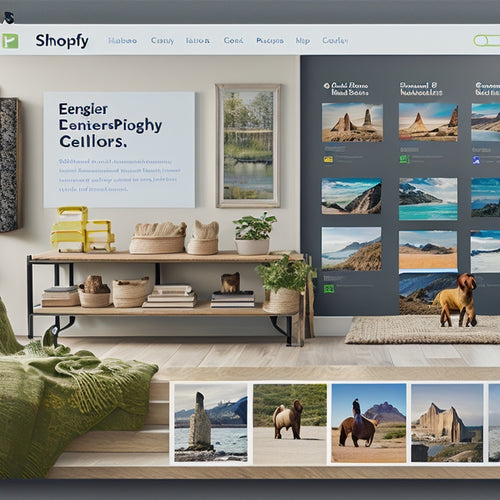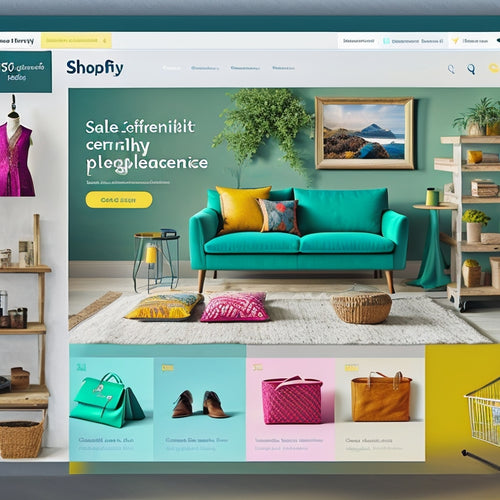
10 Best Online Course Solutions for Customer Feedback
Share
You're likely wasting 95% of the customer feedback you collect, as most companies fail to effectively analyze and act on this valuable data. To get it right, you need a solid understanding of customer feedback solutions. First, establish a feedback system that collects valuable insights online. Then, convert feedback into actionable data by categorizing, analyzing, and prioritizing insights. You'll also need to understand customer pain points, design effective surveys, and analyze customer sentiment. Finally, create a customer-centric culture and use Net Promoter Score effectively to drive customer loyalty. Now, implement these strategies to reveal the full potential of your customer feedback.
Key Takeaways
• Look for courses that cover online feedback collection and analysis, including website and social media platforms, to gain valuable customer insights.
• Opt for courses that teach effective survey design and analysis, including statistical methods for trend identification and open-ended response analysis.
• Choose courses that focus on converting feedback into actionable data, including categorization, prioritization, and development of actionable strategies.
• Select courses that emphasize the importance of creating a customer-centric culture, including regular customer engagement and prompt response to concerns.
• Consider courses that cover advanced topics like sentiment analysis, Net Promoter Score (NPS), and real-time feedback response to drive customer loyalty and retention.
Getting Started With Customer Feedback
To effectively harness customer feedback, you'll first need to establish a system for collecting and analyzing it. This involves identifying the most relevant touchpoints and channels for gathering feedback. This includes determining which customer interactions, such as website visits, phone calls, or in-store purchases, provide the most valuable insights.
You'll also need to decide which channels, like social media, email, or review sites, are best suited for collecting feedback. Once you've identified these touchpoints and channels, you can begin collecting feedback through surveys, feedback forms, or Net Promoter Score (NPS) tracking.
This data will serve as the foundation for your feedback analysis, allowing you to pinpoint areas of improvement and opportunities for growth. Effective feedback analysis is essential for enhancing customer engagement, as it enables you to address pain points, improve customer satisfaction, and foster loyalty.
Collecting Valuable Insights Online
Gathering Valuable Insights Online
By utilizing your website and social media platforms, you can access a wealth of customer insights, uncovering patterns and preferences that guide product development, marketing strategies, and customer experience enhancements. Online feedback platforms offer a plethora of information, enabling you to analyze user experience and pinpoint areas for growth.
| Feedback Method | Pros | Cons |
|---|---|---|
| Online Surveys | Measurable data, easy to analyze | Can be time-consuming, may not reach all customers |
| Social Media Listening | Real-time feedback, cost-efficient | Can be challenging to quantify, may not be representative |
| Website Feedback Forms | Targeted feedback, simple to implement | May not be completed voluntarily, can be biased |
To maximize the value of online feedback, selecting the right methods for your business goals is crucial. By grasping customer satisfaction through online surveys and feedback forms, you can recognize pain points and areas for enhancement. By utilizing social media listening, you can stay informed about customer concerns and preferences. By combining these methods, you can gather a thorough understanding of your customers' needs and preferences, fostering business growth and enhancement.
Turning Feedback Into Actionable Data
You've gathered valuable insights from online feedback, but now it's time to convert this raw data into actionable information that drives business decisions and improvements. This is where the real work begins.
To transform feedback into actionable data, you need to categorize, analyze, and prioritize the insights you've collected. This involves identifying patterns, trends, and areas of opportunity, and then developing actionable strategies to address them.
Effective feedback implementation requires a structured approach. You should create a feedback framework that outlines key performance indicators (KPIs), metrics, and benchmarks. This framework will help you measure progress, track changes, and make data-driven decisions.
Additionally, it's crucial to establish clear roles and responsibilities for feedback implementation, ensuring that everyone involved understands their tasks and deadlines. By following these steps, you can turn raw feedback into actionable data that drives real results.
With the right approach, you can explore the full potential of customer feedback and take your business to the next level.
Understanding Customer Pain Points
When you're gathering customer feedback, it's important that you identify the specific pain points that are causing frustration.
You'll want to pinpoint the sources of these frustrations, whether they're related to product functionality, user experience, or something else entirely.
Pain Point Identification
Identifying customer pain points requires a deep understanding of their experiences, behaviors, and motivations, which can be achieved through various data collection methods and analysis techniques. You need to get into the shoes of your customers and understand their thoughts, feelings, and actions. By doing so, you'll be able to pinpoint the areas where they're struggling the most.
Here are three key aspects to focus on during pain point identification:
-
Frustration hotspots: Identify the specific touchpoints in the user journey where customers are most likely to experience frustration or disappointment.
-
Pain point patterns: Analyze customer feedback to identify recurring themes or patterns that indicate a deeper issue.
-
Emotional triggers: Understand what emotions are driving customer behaviors, such as anxiety, excitement, or disappointment, to develop empathy and create solutions that address their emotional needs.
Common Frustration Sources
When interacting with your product or service, customers commonly encounter frustration sources that can be categorized into several key areas, including usability issues, lack of transparency, and unmet expectations.
These frustrations can have a significant impact on the customer experience, leading to dissatisfaction, negative reviews, and ultimately, lost business.
As you're identifying frustrations, it's vital to recognize that usability issues can stem from poor design, confusing navigation, or inadequate instructions.
Lack of transparency can result from unclear communication, hidden fees, or unexplained changes to your product or service.
Unmet expectations can arise from misaligned marketing promises, inadequate support, or unfulfilled warranties.
Understanding these common frustration sources is essential for improving the customer experience. By acknowledging and addressing these pain points, you can create a more streamlined, user-friendly experience that meets customers' needs and exceeds their expectations.
Root Cause Analysis
To get to the heart of customer dissatisfaction, you need to delve into the core reasons of their pain points, rather than just treating the symptoms. This is where root cause analysis comes in – a problem-solving technique that helps you identify the underlying reasons for customer complaints.
Imagine you're a detective trying to solve a mystery. You gather clues, analyze data, and ask questions to get to the bottom of the issue.
Here are three key steps to help you conduct a successful root cause analysis:
-
Gather data: Collect customer feedback, reviews, and ratings to identify patterns and trends.
-
Analyze clues: Examine the data to pinpoint the root causes of customer dissatisfaction.
-
Verify solutions: Test and validate potential solutions to make certain they address the root causes.
Using Surveys for Deeper Insights
How do you currently collect and analyze customer feedback, and are you making the most out of it?
Surveys are an effective way to gain deeper insights into customer needs and preferences. By designing surveys that ask the right questions, you can gather valuable data that informs your business decisions. Effective survey design is vital in obtaining accurate and actionable feedback. It involves crafting clear and concise questions that are easy to understand, avoiding biases, and ensuring the survey is engaging and user-friendly.
When it comes to feedback analysis, you need to go beyond just collecting data. You must be able to extract meaningful insights from the responses. This involves using statistical methods to identify trends, patterns, and correlations. By analyzing open-ended responses, you can uncover underlying themes and sentiment that may not be immediately apparent. By combining quantitative and qualitative analysis, you can gain a more thorough understanding of your customers' needs and preferences.
Analyzing Customer Sentiment Analysis
Your customer feedback analysis is incomplete without sentiment analysis, which involves deciphering the emotional tone behind customer responses to uncover underlying attitudes and opinions. This pivotal step enables you to grasp the emotional pulse of your customers, identifying areas of satisfaction and dissatisfaction. By applying sentiment analysis benefits, you can pinpoint customer feedback trends, such as recurring complaints or praise, and develop targeted strategies to address them.
Here are three key aspects to contemplate when analyzing customer sentiment:
-
Emotion detection: Identify the emotions expressed in customer feedback, such as happiness, anger, or frustration, to understand their emotional tone.
-
Tone and language analysis: Examine the tone and language used in customer feedback to uncover subtleties in their opinions and attitudes.
-
Contextual understanding: Delve into the context in which customer feedback was provided to gain a deeper understanding of their sentiments and opinions.
Creating a Customer-Centric Culture
By applying the insights gleaned from sentiment analysis, you can now begin to create a customer-centric culture that prioritizes their emotional needs and expectations, driving long-term loyalty and growth. This requires a deliberate effort to listen, respond, and adapt to customer feedback, fostering a feedback loop that encourages continuous improvement.
To achieve this, focus on the following key areas:
| Area | Description | Benefits |
|---|---|---|
| Customer Engagement | Regularly communicate with customers through various channels | Builds trust, encourages feedback, and increases loyalty |
| Feedback Collection | Gather feedback through surveys, reviews, and social media | Identifies pain points, areas for improvement, and opportunities for growth |
| Response and Resolution | Respond promptly to customer concerns, and resolve issues efficiently | Demonstrates empathy, builds trust, and increases customer satisfaction |
| Continuous Improvement | Analyze feedback, identify patterns, and implement changes | Enhances customer experience, drives innovation, and increases competitiveness |
Using Net Promoter Score Effectively
To measure customer loyalty and satisfaction, you can leverage the Net Promoter Score (NPS), a widely adopted metric that provides a clear snapshot of your customers' overall sentiment. By implementing NPS automation, you can streamline feedback tracking and gain a deeper understanding of your customers' needs and pain points. This allows you to identify areas for improvement and make data-driven decisions to drive customer loyalty.
Here are three key benefits of using NPS effectively:
-
Accurate benchmarking: Compare your NPS benchmarks to industry standards to gauge your performance and identify opportunities for growth.
-
Data-driven decision-making: Use NPS data to inform product development, customer service improvements, and marketing strategies that resonate with your target audience.
-
Real-time customer insights: Leverage NPS to gather real-time feedback and sentiment analysis, enabling you to respond promptly to customer concerns and build strong relationships.
Real-Time Feedback and Response
With real-time feedback and response capabilities, you can swiftly acknowledge and address customer concerns, turning negative experiences into opportunities for growth and loyalty. This allows you to stay ahead of potential issues, preventing them from escalating and damaging your brand reputation. By leveraging real-time analysis, you can identify patterns and trends in customer feedback, enabling you to pinpoint areas for improvement and make data-driven decisions.
When customers provide feedback, they expect an immediate response. With real-time feedback and response tools, you can respond promptly, demonstrating that you value their input and care about their experience. This not only resolves issues quickly but also shows that you're committed to continuous improvement.
By closing the loop with customers, you can build trust, increase loyalty, and drive retention. In addition, real-time response capabilities enable you to capitalize on positive feedback, amplifying the voices of satisfied customers and encouraging user-generated content.
Measuring Customer Satisfaction Metrics
When measuring customer satisfaction metrics, you'll want to track key performance indicators that reveal how customers truly feel about your online course.
You can start by calculating your Net Promoter Score (NPS), which gauges customer loyalty based on their likelihood to recommend your course to others.
Additionally, you can utilize sentiment analysis tools to analyze customer feedback and identify patterns in their opinions and attitudes.
Net Promoter Score
You can gauge customer loyalty and satisfaction by calculating the Net Promoter Score (NPS), a widely recognized metric that helps businesses understand their customers' overall experience. By asking one simple question - 'On a scale of 0-10, how likely are you to recommend our product/service to a friend or colleague?' - you can categorize customers into three groups: Detractors (0-6), Passives (7-8), and Promoters (9-10).
Here's what you can do with your NPS:
-
Set realistic NPS benchmarks: Compare your score to industry averages to see how you stack up against the competition.
-
Choose the right NPS software: Select a tool that integrates with your existing systems and provides actionable insights.
-
Analyze NPS trends and develop strategies: Identify areas for improvement and create targeted campaigns to increase customer loyalty.
Sentiment Analysis Tools
Sentiment analysis tools empower you to quantify customer satisfaction metrics by parsing through vast amounts of customer feedback data, extracting emotions, and assigning scores to gauge the overall sentiment. By leveraging these tools, you can uncover hidden patterns and trends in customer opinions, identifying areas that require improvement and opportunities for growth.
Through text mining, you can analyze unstructured data from sources like social media, reviews, and surveys, and transform it into actionable insights. Social media monitoring, in particular, allows you to track customer conversations in real-time, enabling prompt responses to concerns and issues.
With sentiment analysis, you can measure the emotional tone of customer feedback, categorizing it as positive, negative, or neutral. This data-driven approach enables you to make informed decisions, driving business growth and customer loyalty.
Frequently Asked Questions
How Do I Ensure Customer Feedback Is Honest and Unbiased?
Did you know 85% of customers trust online reviews as much as personal recommendations? To prioritize honest and unbiased feedback, you'll want to prioritize feedback authenticity and trustworthiness by minimizing bias and encouraging honesty through anonymous submissions and incentivized reviews.
Can I Integrate Customer Feedback Tools With Existing CRM Systems?
You can seamlessly integrate customer feedback tools with your existing CRM systems, ensuring a unified view of customer opinions while maintaining data privacy, and leveraging CRM integration to drive actionable insights from honest feedback.
What Is the Ideal Frequency for Sending Customer Feedback Surveys?
Like Goldilocks, you're searching for the perfect timing for customer feedback surveys. You'll find it's not too frequent, nor too infrequent, but just right when considering timing aspects, survey response rates, and avoiding survey fatigue to optimize engagement.
How Do I Handle Negative Customer Feedback Publicly Posted Online?
When you encounter negative customer feedback online, you'll want to respond professionally, addressing concerns directly and apologizing for any issues. This helps with managing reputation, showcasing your commitment to customer satisfaction and resolving problems efficiently.
Are Customer Feedback Tools Accessible for Customers With Disabilities?
'When you're selecting customer feedback tools, you'll want to provide seamless accessibility accommodations for users with disabilities, incorporating assistive technology and inclusive design to guarantee a flawless user experience for all.'
Related Posts
-

What Can Shopify Integrate With
This article aims to explore the various integration options available for Shopify. By examining the benefits of int...
-

Which Sales Channel Is Best for Shopify
This article aims to provide an objective analysis of the various sales channels available for Shopify. It explores ...
-

Top Shopify Popup Apps for Growing Your Business
This article provides an overview of the top Shopify popup apps available for growing businesses. Popups are commonl...


